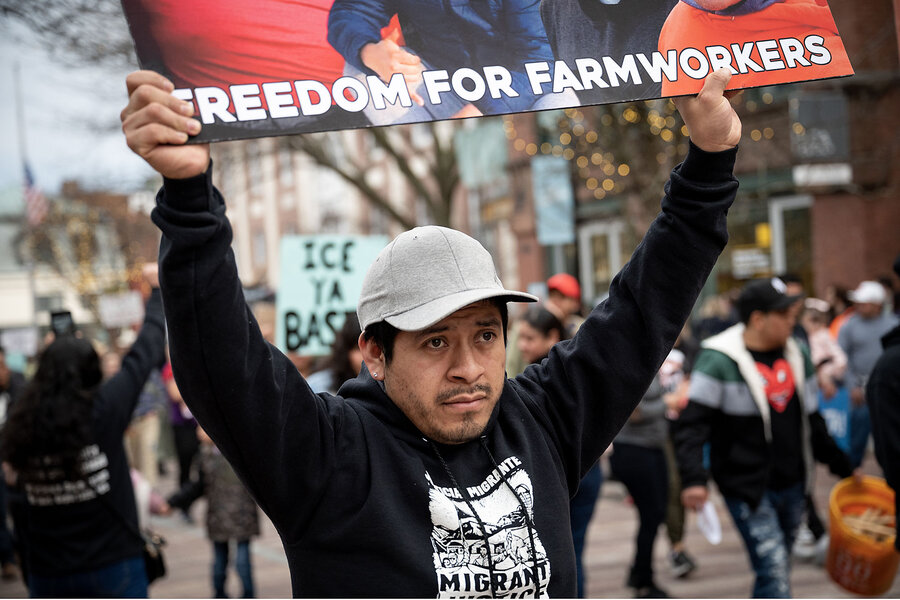LOS ANGELES – The quiet streets of Canoga Park echo a growing unease as recent immigration raids ripple through communities nationwide, leaving many immigrants in hiding.
Ten days after federal immigration officials conducted raids in Los Angeles, a Hispanic woman walks cautiously through the city’s Canoga Park neighborhood. She refuses to give her name, fearing potential repercussions for herself or others. “Right now, we’re hiding,” she says, despite being a legal resident in a community where many lack government permission to live and work. “We don’t want to stand out.”
Immediate Impact
As President Donald Trump intensifies his promised mass deportation campaign, worksite arrests in rural and urban areas are raising questions about the future of the U.S. workforce and economy, which have long relied on immigrants, both documented and undocumented. In a recent crackdown, federal agents arrested 84 unauthorized immigrants at the Delta Downs Racetrack near Vinton, Louisiana.
President Trump has acknowledged that his immigration policies are removing “very good, longtime workers” from sectors such as farming, hospitality, and leisure. The economic impact of these crackdowns remains uncertain, but the policy shifts, arrests, and deportations are already creating a climate of fear and uncertainty.
Key Details Emerge
The Trump administration initially announced increased arrests of unauthorized immigrants, but later instructed Immigration and Customs Enforcement (ICE) to pause arrests at farms, hotels, and restaurants, according to The New York Times. Agriculture Secretary Brooke Rollins expressed full support for “deportations of EVERY illegal alien” in a post on X.
Unauthorized immigrants make up almost 1 in every 10 U.S. workers, with over a quarter in construction and agriculture. – Pew Research Center
Despite these policy reversals, the administration is pushing “self-deportation” and conducting arrests at sensitive sites, including immigration courts. Worksite raids, a longstanding enforcement strategy, have sparked widespread concern among employers and immigrant workers.
Industry Response
From the berry fields of Oxnard, California, to a meatpacking plant in Omaha, Nebraska, reports of targeted worksite arrests have kept immigrants and their advocates on high alert. In Donna, Texas, farmer Nick Billman finds himself alone in the fields, despite his workers having legal work papers. “Zero workers” have shown up since ICE began its latest raids in the Rio Grande Valley, he reports.
Across the nation, American employers and immigrant employees are voicing concerns about the broader consequences of mass deportation. “We’ve never really figured out as a nation what to do with nativist sentiment that says we need to restrict immigration,” says Leticia Saucedo, a professor at the University of California, Davis School of Law.
By the Numbers
Unauthorized workers paid $96.7 billion in taxes in 2022, including $19.5 billion in federal income tax. – Institute on Taxation and Economic Policy
Unauthorized immigrants contributed about $24 billion in Social Security taxes last year. – Penn Wharton Budget Model
What Comes Next
Farmers like Robert Dickey, a Republican state representative in Georgia, are strong supporters of the GOP agenda. While his workers with seasonal work visas continue to show up, he acknowledges that this could change. “It’s essential that we make our agriculture industry competitive,” he says, emphasizing the need for a reliable workforce.
Immigration enforcement expert Austin Kocher from Syracuse University highlights the “sustainability question” as immigrant labor meets key demands in the U.S. economy. “The whiplash of the last few days illustrates the tension within the White House itself about how to approach immigration enforcement policy,” he notes.
Background Context
Modern worksite enforcement dates back to 1986 when President Ronald Reagan signed the Immigration Reform and Control Act, which allowed an estimated 3 million people to gain legal status. The act introduced penalties for employers hiring unauthorized workers, yet issues with document verification have persisted.
Unauthorized immigrants made up 3.3% of the total U.S. population as of 2022, according to the Pew Research Center. “Worksite enforcement remains a cornerstone of our efforts to safeguard public safety, national security, and economic stability,” says Tricia McLaughlin, assistant secretary for public affairs with the Department of Homeland Security.
Regional Implications
In Los Angeles, restaurant manager Gilberto Alvarez faces challenges as employees fear returning to work. “Some took the week off and have yet to return,” he says. If the situation persists, he worries about the long-term impact on his business.
Meanwhile, Representative Dickey recently met with Agriculture Secretary Rollins in Washington to discuss hurricane relief aid and a long-term solution for immigrant labor. “The administration hasn’t done anything to hurt us yet, but we’re hoping they can do something to help,” he says.
For many immigrants, the fear of deportation looms large. Germán, a Venezuelan in Boston, holds a work permit through his pending application for political asylum. “I have a lot of fear about going to work,” he admits, but “I need to work to survive.”
As President Trump urges ICE to conduct raids in “sanctuary” cities, the impact of these policies continues to resonate across immigrant communities. “Usually [ICE will carry out raids] just enough to push people underground,” says Andrew Stettner of The Century Foundation. “But we’re now pushing past that. We’re going into unprecedented territory.”
The labor market, particularly in industries reliant on immigrant workers, hangs in the balance as the nation grapples with the complexities of immigration policy and enforcement.
